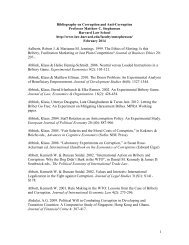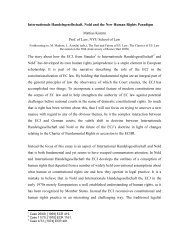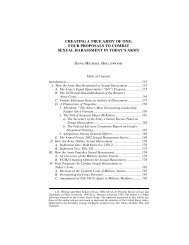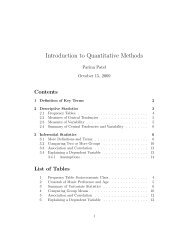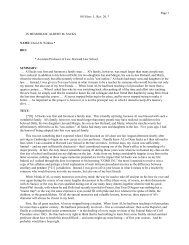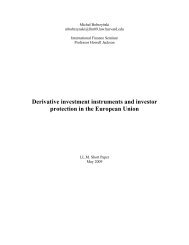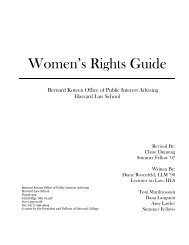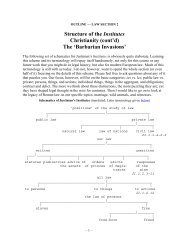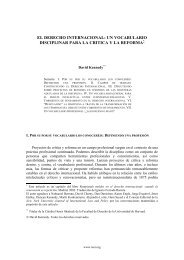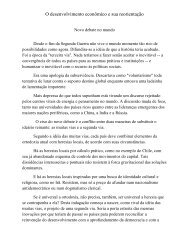Patients as Consumers - Harvard Law School
Patients as Consumers - Harvard Law School
Patients as Consumers - Harvard Law School
Create successful ePaper yourself
Turn your PDF publications into a flip-book with our unique Google optimized e-Paper software.
MLR 106-4 Edit Format Document Hall Mich L Rev.doc<br />
have too often interpreted such contracts indefensibly out of sympathy<br />
for dangerously ill and dying plaintiffs. 151<br />
In short, patients’ vulnerability h<strong>as</strong> long led courts to treat<br />
medical transactions differently from ordinary commercial<br />
transactions. And in non-economic spheres, the law specifically<br />
recognizes that patients’ vulnerability may lead them into poor<br />
decisions. For example, the doctrine of informed consent acknowledges<br />
that patients follow their doctor’s guidance in making medical<br />
decisions: “The patient’s reliance upon the physician is a trust of<br />
the kind which traditionally h<strong>as</strong> exacted obligations beyond those<br />
<strong>as</strong>sociated with arms-length transactions. His dependence upon the<br />
physician for information affecting his well-being . . . is well-nigh<br />
abject.” 152 Informed consent seeks to protect ignorant and dependent<br />
patients by having doctors equip them to make good decisions, even<br />
decisions that are not in the doctor’s interests. 153<br />
In short, regulating markets and protecting consumers is a<br />
standard part of law’s agenda. <strong>Law</strong> specifically ameliorates the<br />
harshness of applying commercial law to medical contracts in multiple<br />
ways. The logical extension of that work is to protect patients in an<br />
agonizing situation—when they must shop in a merciless market and must<br />
incur unknown and uncontrollable obligations for intolerable sums.<br />
But can courts do the job? One court doubted it could set a<br />
“re<strong>as</strong>onable charge” for hospital services “without wading into the<br />
entire structure of providing hospital care and the means of dealing<br />
with hospital solvency.” 154 It could not “solve the problems of the<br />
American health care system, problems that the political branches of<br />
both the federal and state governments and the efforts of the private<br />
sector have, thus far, been unable to resolve.” 155 Similarly, in Pegram<br />
v. Herdrich, 156 the Supreme Court concluded that any line between good<br />
and bad insurance programs “would embody, in effect, a judgment about<br />
socially acceptable medical risk.” 157 However, that judgment would<br />
151. See, e.g., id.; Richard S. Saver, Note, Reimbursing New<br />
Technologies: Why are the Courts Judging Experimental Medicine?, 44 Stan. L.<br />
Rev. 1095 (1992).<br />
152. Canterbury v. Spence, 464 F.2d 772, 782 (D.C. Cir. 1972)<br />
(footnote omitted).<br />
153. Johnson v. Kokemoor, 545 N.W.2d 495 (Wis. 1996).<br />
154. DiCarlo v. St. Mary’s Hosp., No. 05-1665, 2006 WL 2038498, at *4<br />
(D.N.J. July 19, 2006).<br />
155. Id. Another court expressed a similar sentiment: “[T]he Georgia<br />
General Assembly[] [h<strong>as</strong> decided] to let market forces control health care<br />
costs in Georgia. It is outside of the role of this Court to question the<br />
merits of this policy, and appellants’ remedy for any perceived failures in<br />
this scheme is with the legislature not the courts.” Cox v. Athens Reg’l Med.<br />
Ctr., Inc., 631 S.E.2d 792, 797 (Ga. Ct. App. 2006).<br />
156. 530 U.S. 211 (2000). This body of fiduciary law is created by the<br />
Employee Retirement Income Security Act of 1974 (“ERISA”).<br />
157. Id. at 221.<br />
U of M <strong>Law</strong> <strong>School</strong> Publications Center, November 2, 2007, 12:51 PM<br />
Page 32



